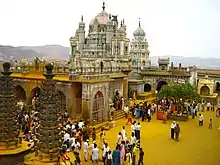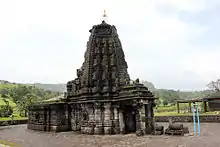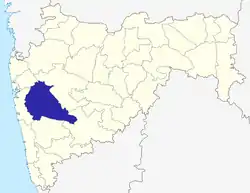Alandi
Alandi is a town and a municipal council in the Pune district in the state of Maharashtra, India. The town is popular as a place of pilgrimage and the resting place of the 13th century Marathi saint Dnyaneshwar.
Alandi
Aalankapuri | |
|---|---|
Town | |
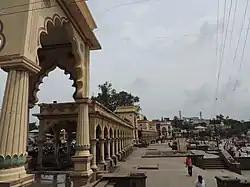 The ghat at Alandi on the Indrayani river | |
| Nickname(s): Alandi | |
 Alandi Location of Alandi in Maharashtra, India 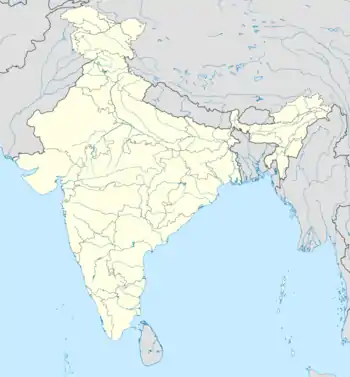 Alandi Alandi (India) | |
| Coordinates: 18.677°N 73.897°E | |
| Country | |
| State | Maharashtra |
| District | Pune |
| Government | |
| • Type | Municipal Council |
| • Body | BJP |
| Elevation | 577 m (1,893 ft) |
| Population (2011) | |
| • Total | 28,576 |
| Languages | |
| • Official | Marathi |
| Time zone | UTC+5:30 (IST) |
| PIN | |
| Vehicle registration | MH 14 |
History
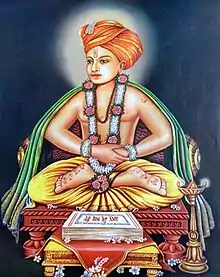
Alandi has a long history but gained prominence in the 13th century when Dnyaneshwar (1275–1296) decided to entomb, otherwise known as sanjeevan samadhi, himself in a samadhi, a form of shrine, under the then existing Siddheshwar temple complex in 1296.[1][2][3] A temple was built over the Samadhi by Ambekar Deshpande in around 1580–1600. Further additions to the temple were made during the Maratha Empire era by Maratha nobles and the Peshwa.[4][5] In 1778, Alandi was granted to Mahadji Shinde, the powerful Maratha statesman of the Maratha confederacy at that time, by the Peshwa. For two decades after that, the Shinde family were the main sponsors of various renovations of the temple.[6]
In the 1820s, Haibatraobuva Arphalkar, a courtier of the Scindia of Gwalior, started the modern Palkhi tradition of carrying the paduka (sandals) of Dnyaneshwar to Pandharpur during the annual Wari. Haibatraobuva was laid to rest under the first step of the temple complex per his will.[1]
Despite being a small town, it was granted municipal status during the early British Raj. The council would raise revenue through levying tax on pilgrims which used to number around 50,000 at the end of 19th century.[7]
Geography
Alandi (18°40′37.42″N 73°53′47.76″E[8]) is located on the bank of the Indrayani River, 18.8 km (11.7 mi) from Khed Taluka of Pune District, near the northern edge of the city of Pune. Alandi has an average elevation of 577 meters (1,893 feet).
Demographics
In 2011, Alandi had a population of 28,576. Males constitute 56% of the population and females 44%.[9] The lingua franca is Marathi. Alandi has an average literacy rate of 73% (82% of the males, 68% of females), which is lower than the national average of 74.04%. 13% of the population is under 6 years of age. All castes are represented in the town census. The closely related Maratha clans, Kurhade-Patil and Ghundare-Patil, dominate the civic life of the town.
Traditionally, many Hindu widows have come to reside in places of pilgrimage such as Pandharpur and Alandi.[10]
Government
Alandi has a Municipal council with a directly elected as Mayor (Nagaradhyaksha). In the 2016 election to the council, The BJP candidate Vaijayanti Umergekar-Kamble was elected mayor by defeating the Shiv sena candidate, Bhagyashree Randhwe. The BJP holds majority in the 18 member town council.[11]
Alandi comes under the Pune district sub-division of Khed taluka. It is a part of Maharashtra legislative assembly constituency of Khed Alandi which in turn belongs to Shirur parliamentary constituency. At present, the assembly seat is held by Nationalist Congress Party's Dr. Amol Kolhe.[12]
Pilgrimage center
Dnyaneshwar samadhi
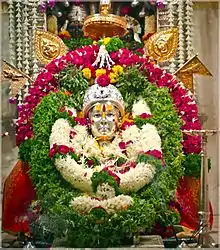
Alandi is a well known place of pilgrimage for Hindu Marathi people because of the town's association with Dnyaneshwar. His devotees believe that he is still alive.[13][14][15] A temple complex was built at Dnyaneshwar's samadhi and is visited by pilgrims, especially those of the Varkari sect. The Ekadashi of the dark half of each month attracts 60-70 thousand pilgrims to the town.[16]
Pandharpur vari

Every year, the Paduka (symbolic sandals) of Dnyaneshwar go on a 21-day Palkhi from Alandi to reach Pandharpur on Ashadhi Ekadashi (June or July in the Gregorian calendar). The Palkhi procession is joined by hundreds of thousand of Varkari devotees for the 150 km journey.[17][18][19]
Kartik Festival
The biggest festival in Alandi is held every year on Kartika Vadya Ekadashi (the eleventh day of the dark fortnight of the Hindu month of Kartik in the Shalivana Shaka calendar). The festival falls close to the day Dnyaneshwar entered Samadhi. This festival or yatra is attended by pilgrims and has a significant economic impact for the local population.[20][21]
Indrayani river
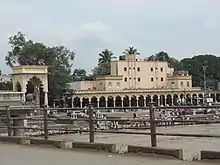
Bathing in the Indrayani River has special significance for pilgrims to Alandi. However, the river is heavily polluted because of sewage discharge by towns along its course and contains high amount of Fecal coliform.[22]
Being a pilgrim center, the stretch of Indrayani River at Alandi, by tradition, has been designated a sanctuary and no fishing takes place. This acts as a sanctuary for river fish such as the Deccan Mahseer.[23]
Pilgrims perform circumambulation around the town during their visit.
Other places of religious significance
The places of interest to pilgrims in and around Alandi include:
- The Dnyaneshwar Samadhi Complex that includes the Samadhi, the Shri Sidheshwar temple and the famed Ajanvriksha tree.[24]
- The ghats on the banks of the Indrayani river.
- Ram Mandir, near the banks of the Indrayani River, south of the Samadhi mandir, is one of the many large temples in Alandi.
- Laxmi Narayan Mandir - is located South to Samadhi mandir, adjacent to Ram mandir, near the River ghat.
- The Vitthal-Rukmini Temple.
- Dnyaneshwari Mandir - a modern temple nearing completion, west of the Dnyaneshwar Samadhi Complex.
- Narsimha Saraswati Math - west of Dnyaneshwar Samadhi Complex en route to the Dnyaneshwari Mandir.
- Shree Gajanan Maharaj Temple complex, south of the Dnyaneshwar Samadhi Complex
- Dnyaneshwar's Wall - according to legend when the Sant Changdev came to visit Dnyaneshwar on a tiger with a snake as a whip, Dnyaneshwar and his siblings went to meet him riding on a wall that moved.[25]
- Sant Jalaram Temple: This temple was built in the 1960s with the same architectural design as the one in Virpur, Gujarat. There is also a temple of Santoshi Mata in the same temple complex.
Other places
- Sambhaji Raje Bhosle Memorial: in Tulapur village, approximately 6 km from Alandi. A memorial to the son of Chhatrapati Shivaji and the second Chhatrapati of Maratha Empire.
- Dehu: the birth, work and worship place of Sant Tukaram and from where the Sant Tukaram flew to Vaikuntha on eagle.[26]
Accommodation
The town also has dozens of dharmshalas that provide lodgings to pilgrims from their respective communities such as the Padmashali or Maheshwari.[27][28] A number of these places also have their own shrines to different deities and Varkari Sants.[29]
Economy

Pilgrim services
The economy of Alandi was historically based around its status as a place of pilgrimage. Although the major festivals in the town are held only twice a year, pilgrims from all over Maharashtra visit the place throughout the year. The needs of the pilgrims are catered for by groups of Brahmins who officiate at the samadhi, weddings, or religious services to the bereaved.[30] Vendors outside the main temple complex offer goods, such as garlands and turmeric, for worshipping at the samadhi along with religious souvenirs and books. Marathi Hindu castes such as the Padmashali have built Dharmashalas (Pilgrim rest houses) that offer accommodation to pilgrims from their castes.[31] The temple's two main festivals occur in Shaka month of Jyeshtha (late June - early July), when the Dnyaneshwar's palkhi departs for the Pandharpur Wari, and in the second half of the Shaka month of Kartik (November). During these festivals, a significant percentage of local population earns income by offering accommodation, catering and other services to the pilgrims. However, a significant number residents also have negative feelings about these festivals.[32] The local Municipal council also collects pilgrim or goods tax for public health provision. A report for Pune metropolitan area in 1991 stated that because of religious nature of the place, industry will not be allowed in Alandi.[33]
References
- Irina Glushkova; Mikael Aktor; Kristina Myrvold (27 August 2014). Objects of Worship in South Asian Religions: Forms, Practices and Meanings. Routledge. pp. 109–113. ISBN 978-1-317-67595-2.
- Mokashi 1987, p. 39.
- W. Doderet (1926), The Passive Voice of the Jnanesvari, Bulletin of the School of Oriental Studies, Cambridge University Press, Vol. 4, No. 1 (1926), pp. 59-64
- Sohoni, Ashutosh (1998). Temple Architecture of the Marathas in Maharashtra Volume One A thesis submitted in partial fulfilment of the requirements for the Degree of Doctor of Philosophy. Leicester UK: De Montfort University Leicester. p. 181. Retrieved 12 April 2019.
- James Burgess; Henry Cousens (1897). Revised Lists of Antiquarian Remains in the Bombay Presidency: And the Native States of Baroda, Palanpur, Radhanpur, Kathiawad, Kachh, Kolhapur, and the Southern Maratha Minor States. Printed at the Government central Press. pp. 12–13.
- Knut A. Jacobsen; Mikael Aktor; Kristina Myrvold (27 August 2014). Objects of Worship in South Asian Religions: Forms, Practices and Meanings. Routledge. p. 124. ISBN 978-1-317-67595-2.
- James Burgess; Henry Cousens (1897). Revised Lists of Antiquarian Remains in the Bombay Presidency: And the Native States of Baroda, Palanpur, Radhanpur, Kathiawad, Kachh, Kolhapur, and the Southern Maratha Minor States. Printed at the Government central Press. p. 18.
- "Maps, Weather, and Airports for Alandi, India". www.fallingrain.com.
- "Census of India 2001: Data from the 2001 Census, including cities, villages and towns (Provisional)". Census Commission of India. Archived from the original on 16 June 2004. Retrieved 1 November 2008.
- Reddy, P. Adinarayana, ed. (2004). Problems of widows in India (1st ed.). New Delhi: Sarup & Sons. pp. 42, 119. ISBN 9788176254793.
- Times, reporter (2016). "आळंदीत शिवसेनेला नमवून भाजप विजयी (The BJP defeats Shiv sena in Alandi)" (December 16, 2016). Maharashtra Times. Retrieved 12 April 2019.
- "Khed Alandi (Maharashtra) Assembly Constituency Elections". Retrieved 12 April 2019.
- Novetzke 2009, p. 218.
- Glushkova 2014, p. 116.
- Bahirat, B.P. (1998). The philosophy of Jñānadeva : as gleaned from the Amṛtānubhava. Delhi: Motilal Banarsidass. p. 15. ISBN 978-8120815742.
- Knut A. Jacobsen; Mikael Aktor; Kristina Myrvold; Irina Glushkova (27 August 2014). "Six". Objects of Worship in South Asian Religions: Forms, Practices and Meanings. Routledge. pp. 109–125. ISBN 978-1-317-67595-2.
- "Maharashtra Tourism". Archived from the original on 27 January 2012. Retrieved 28 October 2012.
- D. B. Mokashi (1987). Palkhi: An Indian Pilgrimage. SUNY Press. pp. 19–22. ISBN 978-1-4384-1341-9.
- James G. Lochtefeld (15 December 2001). The Illustrated Encyclopedia of Hinduism, Volume 1. The Rosen Publishing Group, Inc. pp. 27, 321. ISBN 978-0-8239-3179-8.
- Deshkar, Somnath (2010). "Alandi gears up for Kartik Ekadashi fest" (December 3). Times Of India. Retrieved 15 April 2019.
- Roshen Dalal (2010). Hinduism: An Alphabetical Guide. Penguin Books India. p. 19. ISBN 978-0-14-341421-6.
- "Palkhis ahead, high pollution levels in Indrayani river raise fears" (27 June 2013). Indian express. Retrieved 28 July 2014.
- V. R. Desai; Food and Agriculture Organization of the United Nations (2003). Synopsis of Biological Data on the Tor Mahseer Tor Tor (Hamilton, 1822). Food & Agriculture Org. pp. 27–. ISBN 978-92-5-104933-4.
- Novetzke, C.L., 2009. History, Memory, and Other Matters of Life and Death. Shared Idioms, Sacred Symbols, and the Articulation of Identities in South Asia, pp.212-232.
- Harry Arbuthnot Acworth (1894). Ballads of Marathas. Longmans, Green, and Company. p. xxiv.
- Francesca Orsini (5 December 2016). The History of the Book in South Asia. Taylor & Francis. pp. 80–. ISBN 978-1-351-88831-8.
- Kumaran, K.P. (1992). Migration settlement and ethnic associations. New Delhi: Concept Pub. Co. p. 78. ISBN 9788170223900.
- VILLAGE AND TOWN DIRECTORY Census of India 2011 Part 12A District Handbook Pune (PDF). Government of India. Retrieved 11 April 2019.
- Glushkova 2014, p. 118.
- name="Kumaran1992">K. P. Kumaran (1992). Migration Settlement and Ethnic Associations. Concept Publishing Company. p. 78. ISBN 978-81-7022-390-0.
- Dr. Mahdev D Gurav. A Geographical Study of Fairs and Festivals in Pune District. Lulu.com. pp. 274–275. ISBN 978-1-387-13602-5.
- Summary of the report of the regional plan for Pune metropolitan region, 1970-1991.
Bibliography
- Bahirat, B.P. (1998). The philosophy of Jñānadeva : as gleaned from the Amṛtānubhava. Delhi: Motilal Banarsidass. p. 15. ISBN 978-8120815742.
- Glushkova, Irina (2014), Objects of Worship in South Asian Religions: Forms, Practices and Meanings, Routledge, ISBN 978-1-317-67595-2
- Dallmayr, Fred (2007), In Search of the Good Life: A Pedogogy for Troubled Times, University Press of Kentucky, ISBN 978-0-8131-3858-9
- Dr. Mahdev D Gurav. A Geographical Study of Fairs and Festivals in Pune District. Lulu.com. ISBN 978-1-387-13602-5.
External links
| Wikimedia Commons has media related to Alandi. |
- Sant Eknath Maharaj
- "Dnyaneshwar Samadhi Trust". Archived from the original on 11 April 2015. Retrieved 3 April 2015.
